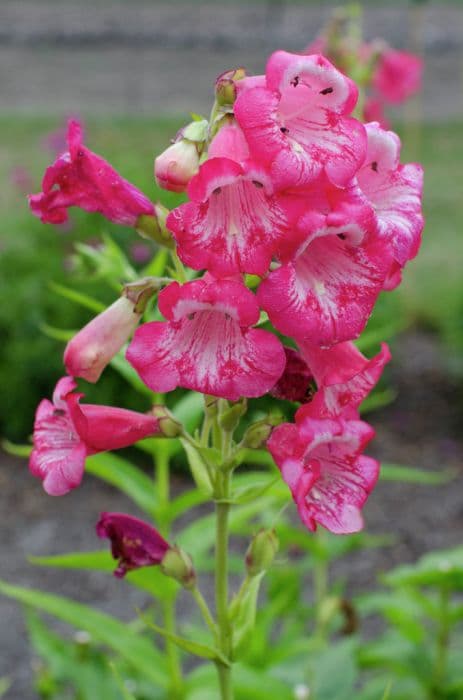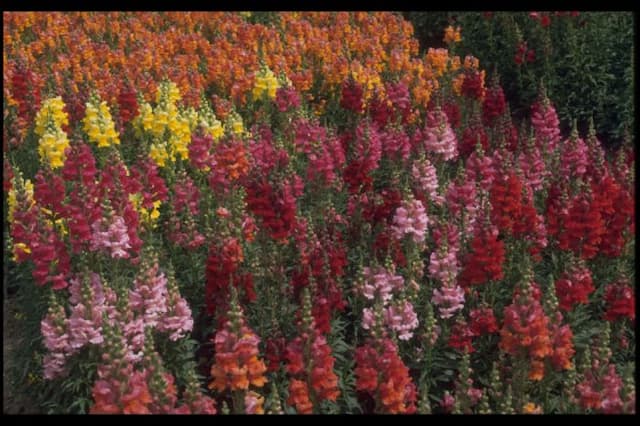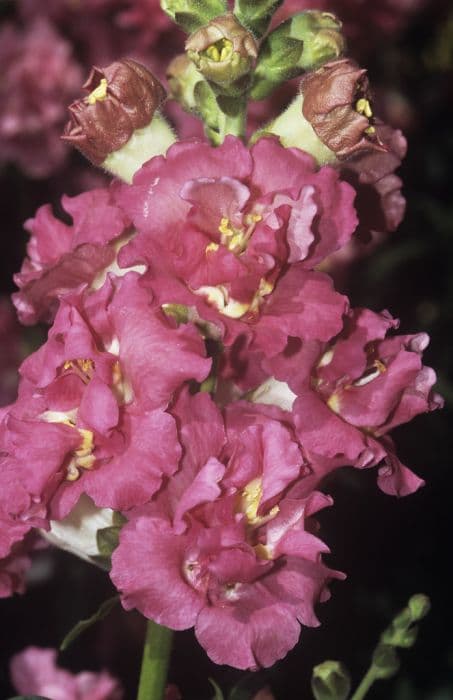Penstemon 'Flamingo' Penstemon 'Flamingo'

ABOUT
'Flamingo' is a semi-evergreen perennial with lance-shaped mid-green leaves. White flowers suffused with bright rose-pink have a white throat marked with deep carmine and carried in tall spires during summer and early autumn
About this plant
 Names
NamesFamily
Plantaginaceae
Synonyms
Beard Tongue, Flamingo Penstemon, Flamingo Beard Tongue
Common names
Penstemon 'Flamingo'
 Characteristics
CharacteristicsLife cycle
Perennials
Foliage type
Deciduous
Color of leaves
Green
Flower color
Pink
Height
2-3 feet (60-90 cm)
Spread
1-2 feet (30-60 cm)
Plant type
Herb
Hardiness zones
4-9
Native area
North America
Benefits
 General Benefits
General Benefits- Attracts Pollinators: The Penstemon 'Flamingo' is known for drawing in bees, hummingbirds, and butterflies, offering a valuable nectar source for these beneficial creatures.
- Drought Tolerance: Once established, this plant has good resistance to drought, reducing the need for frequent watering and making it suitable for xeriscaping or water-wise gardens.
- Low Maintenance: It requires minimal upkeep beyond the occasional deadheading to promote further blooming, making it an easy plant to care for.
- Long Blooming Season: The Penstemon 'Flamingo' has a lengthy blooming period from late spring to early fall, providing a prolonged display of color in the garden.
- Aesthetic Appeal: With its striking pink flowers, it enhances garden aesthetics and can be used for ornamental purposes in borders, rock gardens, or as a focal point.
- Cold Hardy: It is capable of withstanding cooler temperatures, making it suitable for growth in various climates and extending its potential range for cultivation.
- Soil Adaptability: Penstemon 'Flamingo' can thrive in a variety of soil types, as long as they are well-draining, offering flexibility in garden design and placement.
- Erosion Control: Its root system can help stabilize soil and prevent erosion, especially in sloped areas of the garden or landscape.
- Non-Invasive: This plant is not known for being aggressive or invasive, which allows it to fit into mixed beds and borders without overtaking other plants.
- Versatile Usage: It's suitable for use in various garden styles, including cottage gardens, wildlife gardens, rock gardens, and more.
 Medical Properties
Medical PropertiesThis plant is not used for medical purposes.
 Air-purifying Qualities
Air-purifying QualitiesThis plant is not specifically known for air purifying qualities.
 Other Uses
Other Uses- The crushed leaves of Penstemon can be used as a natural dye, providing color for fabrics and materials.
- Penstemon's long flower stalks, once dried, can be used in floral arrangements, adding height and texture.
- Fine artists may use the vivid flowers as subjects for botanical illustration and photography.
- The plant's high nectar production can be exploited in butterfly or bee gardens aimed at supporting local pollinator populations.
- You can utilize Penstemon as a border plant in ornamental gardens to create visually striking divisions between different garden sections.
- Gardeners may also use Penstemons in xeriscaping, a landscaping method that reduces or eliminates the need for irrigation.
- Penstemons can function as a natural soil stabilizer on slopes or areas prone to erosion thanks to their root system.
- The plant's structure can provide microhabitats for small insects and spiders when cultivated in a dense patch.
- To take advantage of their varied blooming times, Penstemon can be used in succession planting to maintain constant color in a garden.
- Aromatic compounds in Penstemon can be included in potpourris or scented sachets for subtle, natural fragrances.
Interesting Facts
 Feng Shui
Feng ShuiThe Beard Tongue is not used in Feng Shui practice.
 Zodiac Sign Compitability
Zodiac Sign CompitabilityThe Beard Tongue is not used in astrology practice.
 Plant Symbolism
Plant Symbolism- Attraction and Charm: The vivid colors and flamboyant shape of the Flamingo Penstemon suggest enchantment and allure, making it symbolic of the power to attract and charm others.
- Boldness and Bravery: This plant’s striking appearance and ability to thrive in tough conditions can symbolize boldness and the courage to stand out.
- Versatility and Adaptability: Penstemons, including the Flamingo variety, are known for their adaptability to various environments, symbolizing versatility and the ability to thrive in diverse situations.
- Balance in Life: The Flamingo Penstemon’s growth habit, with its upright stems and symmetrical flowers, can represent the importance of balance and symmetry in one’s life.
 Water
WaterBeardtongues, including the Penstemon 'Flamingo', should be watered deeply but infrequently, with about 1 inch of water per week. The goal is to encourage deep root growth, so water thoroughly to moisten the entire root zone, then allow the soil to dry out before watering again. In hot, dry periods, you may need to water twice a week, but always check the soil moisture first. Overwatering can lead to root rot, so ensure that the soil is well-draining. In cooler or wetter climates, you may need to reduce the watering frequency to avoid soggy soil.
 Light
LightBeardtongues prefer full sun to partial shade, with a minimum of 6 hours of direct sunlight daily. Penstemon 'Flamingo' thrives best in a spot that receives morning sunlight and some afternoon shade, particularly in hotter climates. Too much shade can lead to weak growth and fewer flowers.
 Temperature
TemperatureBeardtongues can generally handle temperatures down to about 0 degrees Fahrenheit and can tolerate high temperatures as long as they are well-watered. The ideal temperature range for Penstemon 'Flamingo' is between 60 and 70 degrees Fahrenheit. Protect the plant from extreme cold by mulching in late fall.
 Pruning
PruningPrune Beardtongues in the spring to remove any dead or damaged growth from the winter, which helps promote vigorous new growth. Pruning can also be done after the first wave of flowering, typically by deadheading, to encourage a second bloom in late summer or early fall. Cut back the flowering stems by about one-third to one-half after blooming to maintain plant shape and appearance.
 Cleaning
CleaningAs needed
 Soil
SoilBeardtongue 'Flamingo' prefers well-drained soil with a mix of sand, loam, and some organic matter. The best soil mix would consist of two parts garden soil, one part sand, and one part compost or peat moss. An ideal soil pH for this plant should be slightly acidic to neutral, ranging from 6.0 to 7.0.
 Repotting
RepottingBeardtongue 'Flamingo' typically doesn't require frequent repotting and can be repotted every 2-3 years as it prefers to be somewhat root-bound. It's best to repot in the spring before new growth starts.
 Humidity & Misting
Humidity & MistingBeardtongue 'Flamingo' is tolerant of average air humidity and does not require any special humidity conditions. It grows well in the humidity levels typically found in outdoor garden environments.
 Suitable locations
Suitable locationsIndoor
Provide bright light, good airflow, and pot with drainage.
Outdoor
Plant in sunny spot, protect from extreme cold and wet.
Hardiness zone
4-9 USDA
 Life cycle
Life cycleThe life of Penstemon 'Flamingo', commonly known as Beardtongue or Flamingo Penstemon, begins with seed germination, which is typically in spring once the temperature is warm enough. The seedlings develop into juvenile plants with a basal rosette of leaves. As they mature, they develop upright stems with opposite leaves and, by late spring to early summer, Beardtongue produces tubular flowers favored by hummingbirds and bees for pollination. Following pollination, the flowers develop into seed capsules that, once dried, release seeds for dispersal by wind or wildlife. During the colder months, Flamingo Penstemon enters a period of dormancy where growth ceases and the plant may die back, especially in colder climates. Seasonal weather variations and local climates greatly influence the exact timing and duration of each stage.
 Propogation
PropogationPropogation time
Spring-Early Summer
The most common method of propagation for the Penstemon 'Flamingo', also known as Beardtongue, is through stem cuttings. This is typically done in late spring or early summer when the plant is actively growing. To propagate, take a healthy stem cutting about 3 to 5 inches (7.6 to 12.7 centimeters) long, ensuring there are several sets of leaves. Remove the lower leaves and dip the cut end in rooting hormone to encourage root development. Then plant the cutting in a well-draining soil mix, ensuring at least one set of leaves is above the soil surface. Keep the soil consistently moist but not waterlogged and place the pot in a warm area with indirect light. Roots usually develop within a few weeks, after which the new Beardtongue plants can be gradually acclimated to outdoor conditions and eventually planted in the garden.





![Snapdragon [Pretty in Pink]](/_next/image?url=https%3A%2F%2Fplants-admin.emdemapps.com%2Fimages%2Fplants%2F%2Fimages%2F604b5cb3b5385.png&w=640&q=75)



